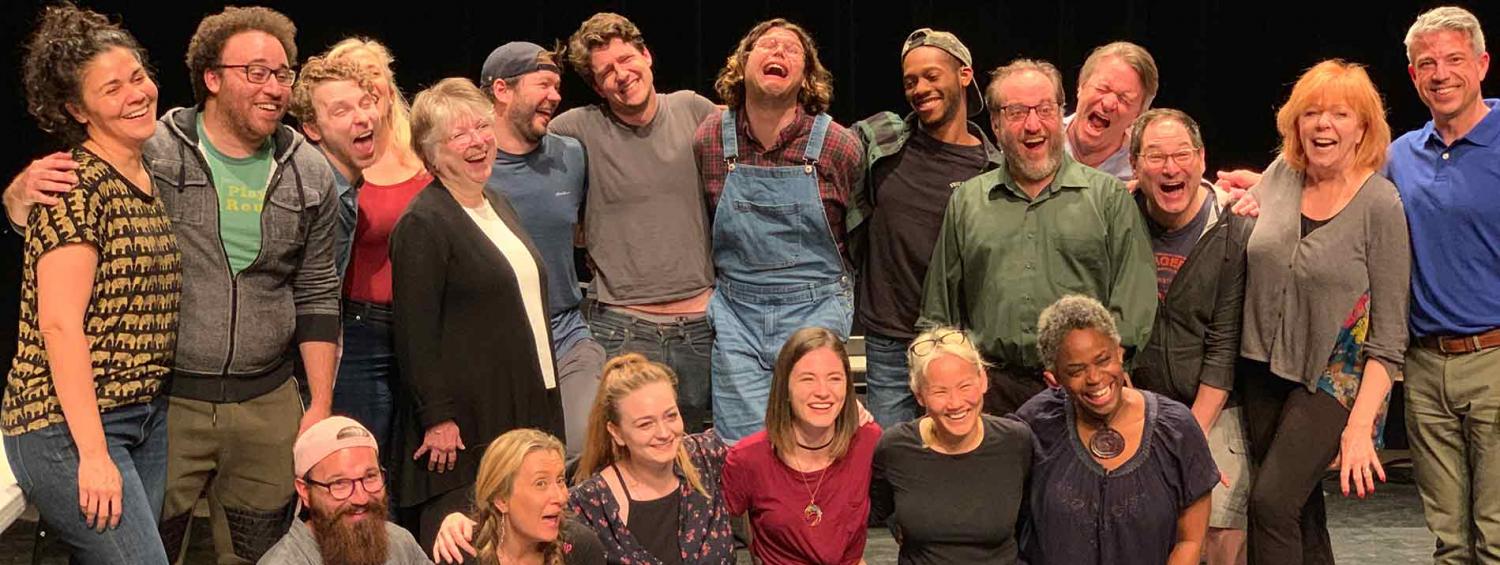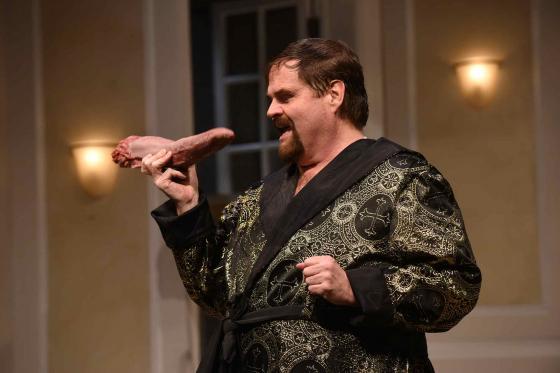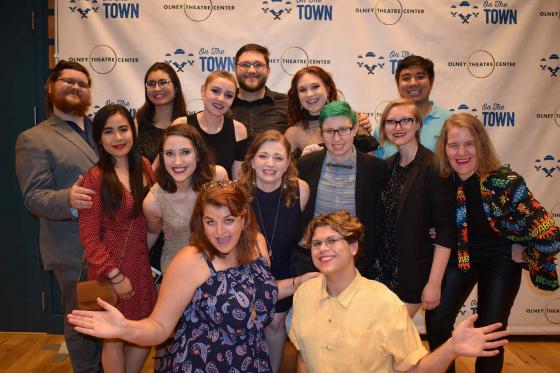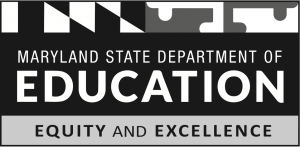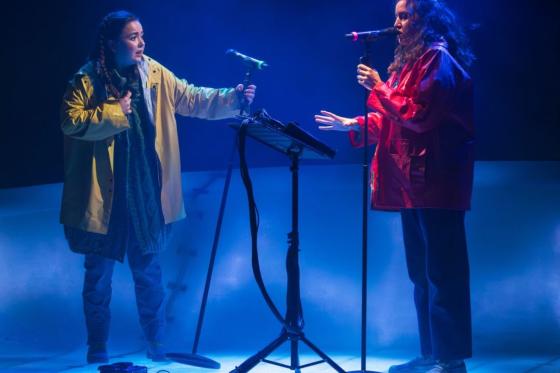Words need not be spoken to be heard. Theatres like Deaf West in Los Angeles, New York Deaf Theatre (NYDT) in New York City, and the touring National Theatre of the Deaf (NTD) have existed for decades, providing both deaf and hearing audiences access to theatre that celebrates deaf talent and culture. But popular recognition of deaf theatrical talent did not arrive until 2015, when Deaf West Theatre’s stunning Tony-nominated production of Spring Awakening transferred to Broadway and shattered the expectations many hearing theatregoers had of what was possible from deaf performers.
Likewise, musical theatre — an art form never really designed with deaf audiences in mind —became more accessible to deaf theatregoers and practitioners. Joey Caverly is a deaf actor and director who has spent time working as an over-hire carpenter as well as full-time carpenter in OTC’s shop since 2015. Inspired by the success of the Spring Awakening revival, Joey began bugging Jason Loewith and Chris Youstra about producing a version of Meredith Wilson’s The Music Man that would combine deaf and hearing actors. After about a year of incubation and of Joey repeatedly walking past Jason Loewith’s office asking, “Music Man?,” OTC greenlit a week-long workshop to explore just how the process of creating this production would work.
When I arrived at OTC as the education apprentice in June 2018 and heard that this workshop was happening, I knew I had to be in the room. I’m deaf, and was born deaf to a completely hearing family, who made the decision to give me a cochlear implant at 5 years old and raise me as close to hearing as I could get. To this day, most people would never know I’m deaf unless I told them. Because I was raised as hearing and not at all involved with the deaf community, I’m not fluent in ASL. I’ve always wanted to meet more deaf people involved in the deaf community and to find people who could relate to the struggles I face. In a lot of ways, I’ve struggled to find my place in between the worlds of the hearing and the deaf, and I had been looking forward to the workshop for months, to the possibility of maybe finding a little piece of myself that I couldn’t find in the hearing world.
This past week, April 2-7, 2019, this workshop finally happened. Workshops generally are used in theatre to test out new productions or new ideas — to get a feel of what works and what doesn’t work — without the pressure of funders or audiences attached to a production’s success. Little did we know that this week-long workshop would light a fire under the pants of every single person involved.
Helmed by a half-deaf, half-hearing creative team of co-directors Alexandria Wailes (deaf) and Michael Baron (hearing), a director of artistic sign language (DASL - essentially an ASL choreographer) Michelle Banks (deaf) and choreographer Karma Camp (hearing), and Music Director Christopher Youstra, this workshop brought together five deaf actors and five hearing actors to explore key moments and songs in The Music Man.
Deaf actors included Sandra Mae Frank (seen as Wendla in the revival of Spring Awakening) as Marian, Joey Caverly (seen in the recent revival of Children of a Lesser God on Broadway) as Marcellus, with Amelia Hensley (Thea in Spring Awakening revival) as well as Monique Holt, and Andrew Morrill. Hearing actors included DC favorites Sam Ludwig as Harold Hill and Donna Migliaccio as Mrs. Paroo, with Heather Beck, John Sygar, and Calvin McCullough rounding out the ensemble. Additionally, Ethan Sinnot (a deaf theatre practitioner and designer in the DC region who teaches at Gallaudet University) and Rosemary Pardee Slocum (a hearing costume designer and former OTC resident costume designer) were present as design advisors. Richard Lundy (a hearing stage manager who previously worked with deaf theatre companies) served as the stage manager, and Trent Harper (a recent Gallaudet grad and deaf theatre practitioner) and myself served as assistant stage managers/production assistants. Finally, we had a rotating team of 14 ASL interpreters, four at a time every day, to help facilitate communication between all parties.
I list everyone involved because not only is it important to acknowledge the commitment of artists to a process like this, but also because what was so magical and revolutionary about this particular workshop is the intentionality with which the team was created — nearly half and half deaf and hearing. This intentionality characterized the entire process. Intention with this particular story was immeasurably important, as The Music Man is a story not written with any kind of deaf audience in mind. It follows the story of Harold Hill, a traveling salesman who scams towns by selling bands — the instruments, the uniforms, the instruction books — and by promising to teach the children how to play, only to leave town just before the promised concert. However, in River City, Iowa, he runs into an old friend and colleague Marcellus, and falls in love with Marian, the town’s music teacher and librarian. With many fast patter-type songs and with its subject matter being the creation of a band in the town, The Music Man was written for people who can hear and make audible sense of it.
Musical theatre is an art form that was created (like most popular culture) to prioritize the experience of hearing audiences — even Spring Awakening received criticism for being much more accessible to hearing audiences than to deaf audiences. It employed “sim-com” (signing as you speak, which is considered rude to many in the deaf community). and did not follow the rules of ASL grammar. Spring Awakening cracked the door for deaf representation and participation in musicals, but it still was not wide enough for everyone to pass through.
Our goal with this workshop was to pick several key moments in The Music Man to explore the way in which we can make a musical production equally accessible to deaf and hearing audiences. Our guiding question for the week was not “How do we tack on ASL and fit deaf people into this show to make it accessible for deaf audiences?” but instead “How do we take the truths of the people in this room, the truths of the people in this story, and come together to create a larger truth about this town and the people in it?” Our River City, Iowa, became not a community of people divided between the lines of deaf and hearing, but a community in which deaf and hearing people communicated honestly and openly in the ways they could in order to be understood.
Making Harold Hill hearing while making Marcellus (with whom Harold previously ran scams) and Marian deaf allowed us to explore how this hearing man comes into a community that is already “Iowa Stubborn” (a song in the show that explains that River City people are close-minded to outsiders) and grows in his ability to communicate. By the end of the play, Harold Hill becomes a changed man because of his love for Marian — the fact that he has to pick up some ASL and try much harder to communicate adds to that change. Marian, too, changes — she drops her Iowa Stubbornness and opens herself up to someone else.
With Harold and Marcellus, we came to see a deep, close friendship that developed despite Harold’s lack of proficiency in ASL. In the scenes between the two of them, a combination of speaking, gesture, and ASL was used to communicate the dialogue. With our deaf and hearing co-directors, we were able to better evaluate if the communication was effective for both deaf and hearing audiences.
A particularly revolutionary moment was the opening number, Rock City, which Chris Youstra describes as the first musical theatre rap because the song is entirely without accompaniment and is supposed to emulate the sound of the train that the ensemble is on. We chose to forego having the patter of the number voiced character by character and instead have Harold Hill masquerade as the conductor, singing the song aloud while the rest of the ensemble, both deaf and hearing actors signed the song. Not only did it establish Harold Hill as an outsider and a con man, it prioritized the ASL and very effectively conveyed the motion of the train in a visual way.
These are just a few of the moments we experienced and created together in one too-short week. Our workshop, again, was process-oriented rather than product-oriented, about how this kind of thing can work and what discoveries we made along the way that could lend itself to a possible full production of The Music Man — or any other musical — that would combine deaf and hearing creative teams and casts. The process was illuminating and gratifying and emotional for everyone in the room.
On the last day, we spent our final hour debriefing and discussing our experiences with the project. We talked of how deafness is an invisible disability and how this process makes it visible, and how the product makes apparent the effort it takes to connect on a human level. We talked of how we together found not two languages but one, both theatrically and literally, of how the directorial conversations were not of ASL or spoken English, but of how to remain authentic and truthful. I found a new community of people to whom I felt I belonged — nobody in that room did not belong. My own and others’ deafness was celebrated, not hidden; the language of deaf culture was prioritized and celebrated.
It was an emotional conversation for all involved — this kind of hyper-intentional space and all of our identities converged as a collection of misfits trying to come together and tell a story, to communicate a truth as simply and as honestly as we could. And the simple, honest truth that I can’t even begin to fully articulate in a (not-so) brief blog post is that every single one of us walked away with the realization that this kind of process and product has the potential to radically change musical theatre — to make it more inclusive and accessible, and to celebrate what every individual has to offer.
